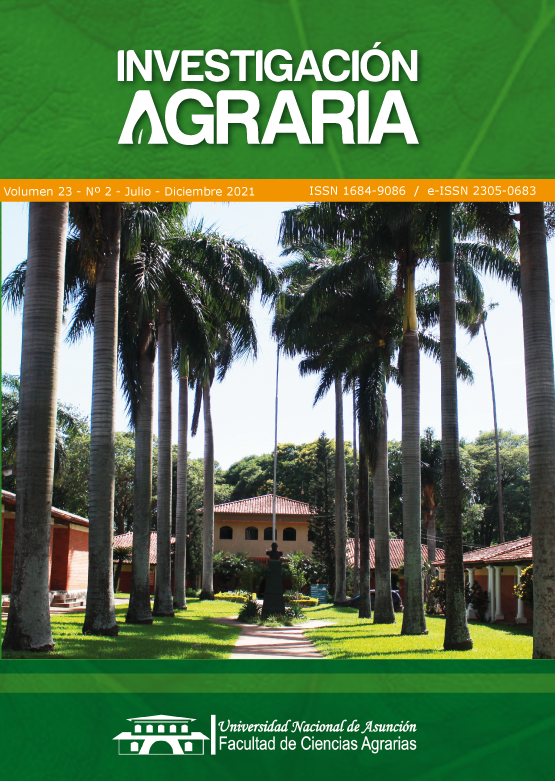Comparison of the initial development of four species in forest restoration plots with three different soil preparation systems in the department of Caazapa, Paraguay
DOI:
https://doi.org/10.18004/investig.agrar.2021.diciembre.2302676Keywords:
Campomanesia xanthocarpa, Cordia americana, Cordia trichotoma, Melia azedarach, Forest Restoration, Soil preparationAbstract
As a result of the advance of the agro-livestock frontier, the Alto Paraná ecoregion has lost more than 90% of its original surface, currently leaving only isolated remnants of this ecosystem. Thus, this ecoregion’s restoration efforts and their success are key to the conservation of the biodiversity that it harbors. In this context, the objective of this work was to know the initial development of Campomanesia xanthocarpa, Cordia americana, Cordia trichotoma and Melia azedarach under three land preparation systems in a restoration project: i) manual drilling, ii) controlled burning + manual drilling and iii) conventional land preparation; in four plots in the Golondrina farm, Caazapá. The data collected were (a) diameter at neck height (DNH), (b) height, and (c) number of branches. For data analysis, ANOVA and the Tukey-Kramer testwere performed. Cordia americana was the species with the best development in the three variables studied in the three soil preparation systems, while Campomanesia xanthocarpa had the lowest development among the four species studied. Cordia trichotoma was the second best-developing species followed by Melia azedarach, which was affected by frost.Downloads
Metrics
References
Aerts, R. & Honnay, O. (2011). Forest restoration, biodiversity and ecosystem functioning. BMC Ecology. Disponible en: http://www.biomedcentral.com/1472-6785/11/29
Bento, L., Quintao, S. & Dresch, D. P. (2016). Potential for recovery of Campomanesia xanthocarpa Mart. ex O. berg seedlings from water deficit. African Journal of Agricultural Research, 11 (30), 2775-2785.
Brassiolo, M. & Gomez, C. (2004). Manejo de la regeneración natural de Paraíso (Melia azedarach) en el Chaco Húmedo. Quebracho, 11, 42-53.
Carvalho, P. (1998). Espécies introduzidas alternativas às dos géneros Pinus e Eucalyptus para reflorestamento no Centro-Sul do Brasil. Em A.P.M. Galvão, Espécies não tradicionais para plantios com finalidades produtivas e ambientais. Colombo: Embrapa Florestas, 75-99
Carvalho, P. (2004). Guajuvira: Patagonula americana. Embrapa Amazônia Oriental. Brasília: Embrapa
Florestas. Disponible en: http://ainfo.cnptia. embrapa.br/digital/bitstream/CNPF-2009-09/41468/1/circ-tec97.pdf
Da Ponte, E. D., Mack, B., Wohlfart, C., Rodas, O., Fleckenstein, M., Oppelt, N., . . . Kuenzer, C. (2017). Assessing Forest Cover Dynamics and Forest Perception in the Atlantic Forest of Paraguay, Combining Remote Sensing and Household Level Data. Forests, 8 (10), 389.
Evans, P. & Rombold, J. (1984). Paraiso (Melia azedarach var. “Gigante”) woodlots: an agroforestry alternative for the small farmer in Paraguay. Agroforest Syst, 2 (3), 199-214.
FAO. (2015). Global Forest Resources Assessment 2015. Food and Agriculture Organization of the United Nations. Rome: FAO. Obtenido de www.fao.org/forest-resources-assessment
FAO. (2018). El estado de los bosques del mundo. Roma. Recuperado de: http://www.fao.org/publications/es
Gaburro, T., Zanetti, V. & Gama, V. (2015). Physiological variables related to photosynthesis are more plastic than the morphological and biochemistry in non-pioneer tropical trees under contrasting irradiance. Brazil Journal of Botany, 38, 39-49. doi:10.1007/s40415-014-0113-y
Heber, D. (2016). Estudio de las propiedades físicas y químicas del suelo producidas por la quema controlada de vegetación en el Municipio de Cuarimbo, Departamento del Vichada. Cuarimbo: Universidad de Caldas.
Intergovernmental Panel on Climate Change. (2019). IPCC Special Report on Climate Change and Land. Roma: IPCC.
Insfrán, A., Cruz-Alonso, V., Viñegla, F., Aparicio J., Amarilla, M. & Ibarra, J. (2014). Primeros estudios sobre restauración de ecosistemas en la Facultad de Ciencias Agrarias de la Universidad Nacional de Asunción. Asunción: Fundación Internacional para la Restauración de Ecosistemas (FIRE).
Jacobs, D., Oliet, J., Aronson, J., Bolte, A., Bullock, J., Donoso, P., . . . Weber, J. (2015). Restoring forests: What constitutes success in the twenty-ï¬rst century? New Forests (46), 601-614.
Klein, D., Andrade, M., Derengoski, J., Duarte, E., Krefta, S., Silveira, A. & Brun, E. (2016). Aspectos gerais e silviculturais de Cordia americana, Aspidosperma polyneuron, Toona ciliata e Khaya spp. Revista de Ciéncias Agroveterinárias, 15(2), 155-164. Recuperado de: https://www.researchgate.net/publication/305806802_General_and_silvicultural_aspects_of_Cordia_americana_Aspidosperma_polyneuron_Toona_ciliata_e_Khaya_spp
Lof, M., Dey, D., Navarro, R. & Jacobs, D. (2012). Mechanical site preparation for forest restoration. New Forests, 43, 825-848.
Londe, V., De Sousa, H. & Kozovits, A. (2017). Exotic and invasive species compromise the seed bank and seed rain dynamics in forests undergoing restoration at urban regions. Journal of Forest Restoration, 28, 1019-1026. doi:https://doi.org/10.1007/s11676-017-0370-2
Navarro, R., Del Campo, A. & Cortina, J. (2006). Factores que afectan al éxito de una repoblación y su relación con la calidad de la planta. En J. P. Cortina, Calidad de planta forestal para la restauración en ambientes Mediterráneos. Estado actual de conocimientos. Madrid: Organismo Autónomo Parques Nacionales.
Pimenta, J. A. (1998). Estudo populacional de Campomanesia xanthocarpa O. Berg (Myrfaceae) no Parque Estadual Mata Godoy, Londrina, PR. Campinas, SP: Universidade Estadual de Campinas.
Rodrigues, R. R., Santin, P. & Isernhagen, I. (2009). Pacto pela restauração da mata atlántica : referencial dos conceitos e ações de restauração florestal. Sao Paulo: LERF/ESALQ : Instituto BioAtlántica.
Salas-Dueñas, A. & Facetti, J. (2007). Biodiversidad del Paraguay: una aproximación a sus realidades. 235 p.
Samojeden, C., Artusi, Á., Delevatti, H., Milesi, S., Cansian, R. & Sausen, T. (2018). Light environment influences the flood tolerance in Cordia americana (L.) Gottschling & J.S.Mill. Anais da Academia Brasileira de Ciéncias, 90(3), 2945-2953.
SEAM. (2013). Resolución N° 614/2013 de ecorregiones del Paraguay. Asunción: Secretaría del Ambiente.
Sturgess, B. (2019). Measuring Natural Capital and the Causes of Deforestation. World Economics, 20 (3), 39-62.
Published
How to Cite
Issue
Section
License
Copyright (c) 2021 Paulo Caetano Medina Avalos, Lourdes González Soria, Enrique Benítez León, Gisselle Villalba

This work is licensed under a Creative Commons Attribution 4.0 International License.
All content in this journal is under Creative Commons Attribution License.









 All content in this journal is under
All content in this journal is under 